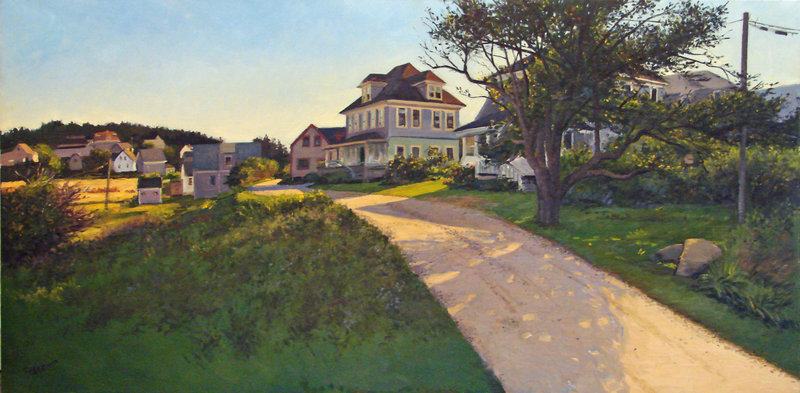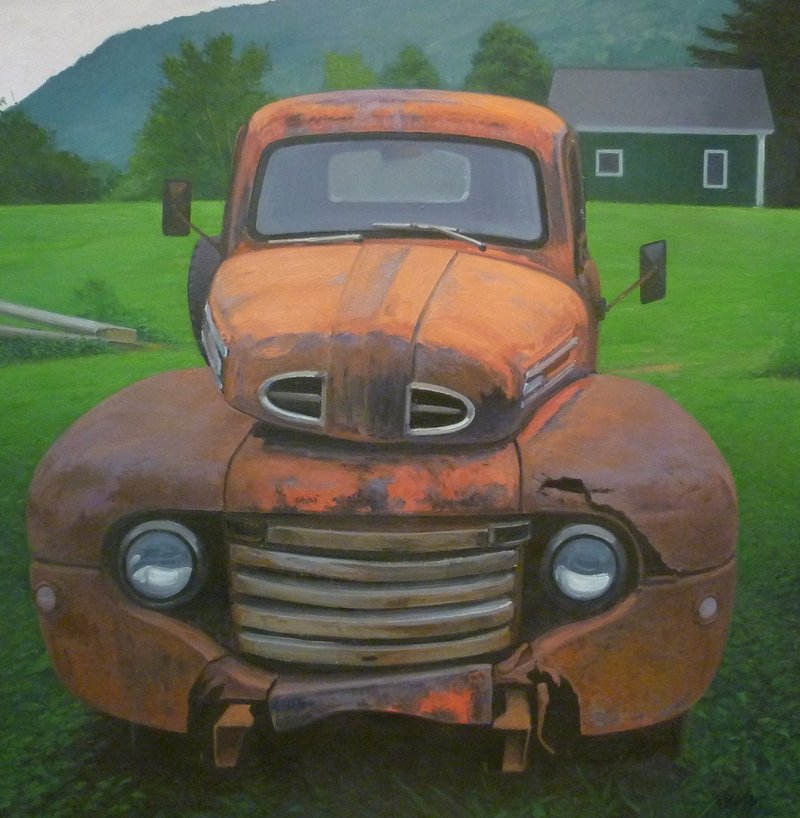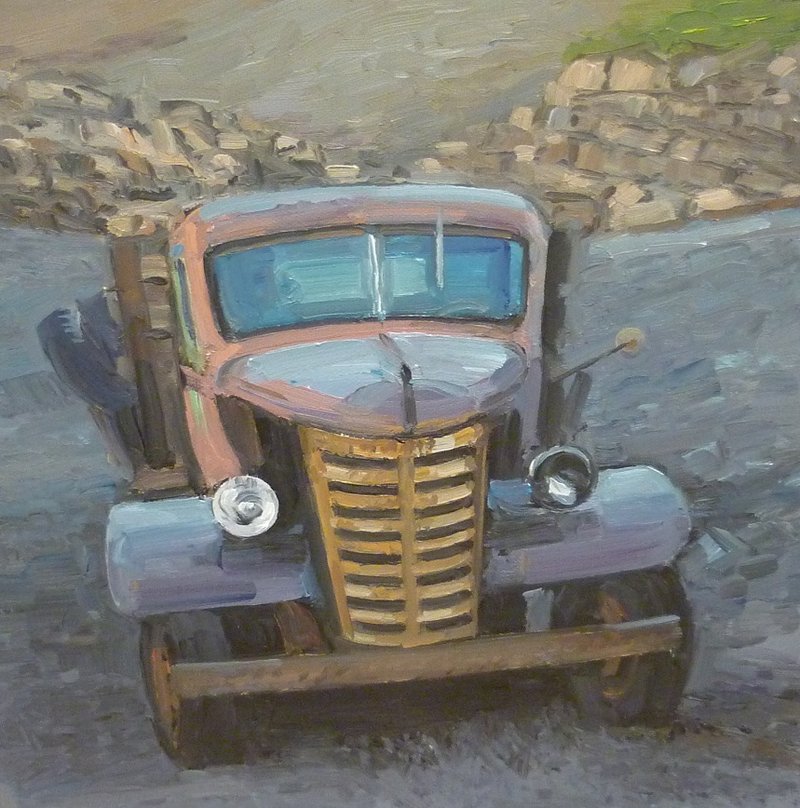When I walked into the “Paintings of Landscapes and Trucks,” I was immediately struck by Kevin Beers’ “Woodstock Ford,” a 4-foot-square canvas with the rusted but curvy old truck front and center, parked on the grass. Clear and well-painted, it pops.
The show at Gleason Fine Art in Portland features a couple of dozen other paintings, mostly from the last couple of years, that gather into subsets of dilapidated trucks, landscapes and views of Maine coastal towns. Monhegan provides Beers’ sense of place with several views of the lightkeeper’s house and other buildings on the island.
One of my favorite paintings in the show is “Main Street, Monhegan.” To some, it could appear a bit distracted and difficult to read, because it doesn’t have an obvious object or spatial flow. You could see that as a flaw, or — like I do — as a hint about the ambitious complexity of the painting.
The view (apparently the spot where Beers placed his easel while painting the composition) is just off a dirt road that swoops up through the lush growth only to find its path surprisingly halted visually at a tall, handsome Victorian house perched at the top of the composition.
Taking over from our inability to visually travel the road any farther, the house’s porch reaches like a gesturing arm toward another 10 or so buildings. At a point, our physical travel would end and switch over to visual investigation.
Beers ensures there was never any doubt about the physical/visual narrative by blocking what would have been the first possible stop from the road — another big, old house. The massive tree that blocks the closer house also reinforces the logic of the painting’s flow, with its only naked branch extending toward the Victorian house.
The thing about “Main Street,” however, is its apparent comfortable humility. It’s a quiet painting most notable for its pleasant — almost lazy — light.
Oddly, this ambitious project reminds me of Rackstraw Downes, a brilliant painter who makes painstakingly complex paintings from mundane or even bleak scenes. But I like Beers’ Monhegan so much more because it focuses on the appeal of the scene rather than the self-aggrandizement of the artist.
“Main Street” is one of those paintings worth giving a chunk of your time. When we see gallery or museum shows, we generally walk past the vast majority of works — only looking at each work long enough to categorize it within the standards of genre and the artist’s oeuvre. We only give any work extra attention if it makes a case for being unusually important (scale, recognition, prominence of placement, etc.).
What we don’t do often enough is let ourselves be held in place by any given painting. If you have, say, 20 minutes to see this show, I suggest you spend 10 minutes in front of “Main Street” or “Woodstock Ford.”
“Ford” is an easier painting on the eyes. It seems so simple and robust. While “Main Street” is nicely painted, the old red truck is a better vehicle for some really terrific brushwork: The impasto strokes of the font-end rust are fantastically dry, and sit in beautiful contrast to the surprisingly squishy strokes that define the internal depth of the rounded headlights.
While Beers shows he can excel at mark making, he also insists on holding us within lusciously diffused evening light. The opalescent sky tells us the time of day. The chartreuse tinge of the grass gives us the season (early summer). A hint of fence to the left of the truck places us just on the edge of the less traveled — but not yet quiet — dirt road. These masterful touches subtly build up their own camouflage.
“Ford” is much more than just a truck. It’s a landscape. It’s a still life. A portrait. A place. An illustration. It’s a real chunk of life with its own memories, histories and stories that will be stoically and silently filed forever in this painting. It’s like a Maine version of “American Gothic.”
I like most of the paintings in the show, although I was disappointed by several of the smaller landscapes where disjunctive textures get in the way of Beers’ sense of atmospheric coherence.
One of my favorite paintings is a tiny truck — “Still Working” — that almost falls apart up close, and yet from a distance sits perfectly in fading crepuscular light.
Monhegan isn’t new, and Beers certainly isn’t the only artist to paint old trucks, but the point of pursuing genres and series is to challenge recognizable conventions even if by means of subtleties and refinement.
Beers, who succeeds on these terms, is a very good painter with a quiet and interestingly smart voice of his own.
Freelance writer Daniel Kany is an art historian who lives in Cumberland. He can be contacted at:
dankany@gmail.com
Send questions/comments to the editors.





Success. Please wait for the page to reload. If the page does not reload within 5 seconds, please refresh the page.
Enter your email and password to access comments.
Hi, to comment on stories you must . This profile is in addition to your subscription and website login.
Already have a commenting profile? .
Invalid username/password.
Please check your email to confirm and complete your registration.
Only subscribers are eligible to post comments. Please subscribe or login first for digital access. Here’s why.
Use the form below to reset your password. When you've submitted your account email, we will send an email with a reset code.